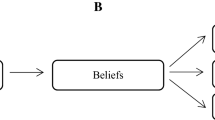Abstract
The authors propose a method of teaching anger management utilizing an objects relations theory conceptualization. The inner structure of the angry adolescent is described, and methods of addressing anger tailored to the individual differences of each adolescent's internal world are presented Role playing is utilized in the anger management group to illustrate the concepts presented. The authors conclude that when the clinical intervention resonates with the internal world of the client, the intervention will be experienced as meaningful.
Similar content being viewed by others
Reference
Blacker, K, Tupin, J. (1977). “Hysteria and Hysterical Structures: Developmental and Social Theories. In Horowitz ed., Hysterical Personality. New York: Jason Aronson.
Bowlby, J. (1958). “The Nature of the Child' Tie to his Mother,” Int. J. Psa. 39: 350-370.
Bursten, B: The manipulative personality. Arch Gen Psychiatry 26: 318-321, 1972.
Cadoret, RJ. Epidemiology of antisocial personality, in Unmasking the Psychopath: Antisocial Personality and Related Syndromes. Edited by Reid, WH, Dorr, D, Walker, JI, et al. New York, WW Norton,1986, pp. 28-44.
Celani, D. (1994). The Illusion of Love. New York: Columbia University Press.
Fairbairn, W. R.D. (1940). Schizoid factors in the personality. In Psychoanalytic Studies of the Personality. London: Routledge & Kegan Paul, 1952, pp. 3-27.
Gunderson, JG., Zanarini MC, Kisiel, CL.: Borderline personality disorder: a review of data on DSM-III-R descriptions. Journal of Personality Disorders 5:340-352, 1991.
Henderson, D. K. and Gillespie, R. D. (1969). Textbook of Psychiatry: For Students and Practioners, 10th. ed., rev. I. R.C. Bachelor. London: Oxford University Press.
Holden, C. Growing focus on criminal careers. Science 233:1377-1378, 1986.
Horner, A. (1979). Object Relations and the Developing Ego in Therapy. New York: Jason Aronson.
Kernberg, O. F. (1976). Object Relations and Clinical Psychoanalysis. New York: Jason Aronson Inc.
Kernberg, O. F. (1985). Borderline Conditions and Pathological Narcissism. Northvale, NJ., Jason Aronson.
Klein, R. (1989) “Shorter-term Psychotherapy of the Personality Disorders” in, Psychotherapy of the Disorders of the Self. In J. Masterson and R. Klein eds., New York: Brunner/Mazel.
Kohut, H. (1971). The Analysis of the Self. New York: International Universities Press.
Mahler, M. S. “Thoughts about Development and Individuation,” in The Psychoanalytic Study of the Child, Vol. 18. New York: International Universities Press, 1963, pp. 307-324.
Masterson, J. (1981). Narcissistic and Borderline Disorders. An Integrated Developmental Approach. New York: Brunner/Mazel.
Masterson, J. and Rinsley D. (1975). “The Borderline Syndrome: The Role of the Mother in the Genesis and Psychic Structure of the Borderline Pesonality,” Int. J. Psa., 56: 163-178.
Meissner, W. W. (1976). Psychotherapeutic Schema based on the Paranoid Process. International Journal of Psychoanalytic Psychotherapy. 5: 87-113.
Meissner, W. W. (1980). The Problem of Internalization and Structure Formation. International Journal of Psycho-Analysis 61: 237-248.
Meloy, JR (1988). The Psychopathic Mind: Origins, Dynamics, and Treatment. Northvale, NJ, Jason Aronson, Inc.
Prior, Steven. (1996). Object Relations In Severe Trauma, Psychotherapy of the Sexually Abused Child. Norvale, New Jersey, Jason Aronson Inc.
Rosenfeld, H. (1971). A Clincial Approach to the Psychoanalytic Theory of the Life and Death Instincts: An investigation into the Aggressive Aspects of Narcissism. International J. Psychoanalysis, 52: 167-178.
Rutter, M. and Giller, H. (1983). Juvenile Delinquency: Trends and Perspectives. New York: Penguin.
Stark, M. (1994). A Primer on Working with Resistance. Northvale, New Jersey. Jason Aronson, Inc.
Wolf, E. S. (1988). Treating the Self, Elements of Clinical Self Psychology. New York: The Guilford Press.
Rights and permissions
About this article
Cite this article
Patrick, J., Rich, C. Anger Management Taught to Adolescents with an Experiential Object Relations Approach. Child and Adolescent Social Work Journal 21, 85–100 (2004). https://doi.org/10.1023/B:CASW.0000012350.87785.d2
Issue Date:
DOI: https://doi.org/10.1023/B:CASW.0000012350.87785.d2




